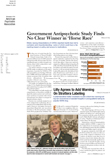Hospitalized children under age 18 were 90 percent more likely to have been admitted with a diagnosis of bipolar disorder in 2000 than in 1995.
Moreover, the children were 50 percent more likely to have been admitted with an eating disorder diagnosis, according to a report published in the August Social Psychiatry and Psychiatric Epidemiology.
Overall, there was a significant reduction in the percentage of insured children admitted for inpatient psychiatric services, from 0.36 percent in 1995 to 0.23 percent in 2000, reported lead author Illan Harpaz-Rotem, Ph.D., and colleagues.
There was also a significant change in the proportion of boys and girls admitted to inpatient psychiatric services during those years. The percentage of girls increased from 47.7 percent to 52.3 percent, while that of boys decreased from 52 percent to approximately 47 percent.
The authors also found that while the percentage of hospitalized youngsters aged 13 to 18 decreased significantly, from 83.2 to 80.4 percent, the percentage of youngsters aged 7 to 12 increased significantly, from 13.7 to 17 percent.
Data for the study were obtained from Medstat's MarketScan. This database compiles claims from private health insurance plans nationwide and includes information on adults and their dependents insured through the benefit plans of large employers. Medstat collects the claims data, standardizes their formats, and aggregates them in a single file. More than 200 insurance companies contribute information on their claims to the database, which contains information on more than 8 million covered lives from 1995 to 2000.
The study sample consisted of 5,346 children younger than age 18 for whom claims were submitted for inpatient mental health services in either 1995 (n=3,869) or 2000 (n=1,477) and was extracted from data on 1,723,681 children included in the database during these years.
Overall, there was a 50 percent decrease in substance abuse diagnoses, a 45 percent decrease in anxiety disorders, a 33 percent decrease in adjustment disorders, and a 36 percent decrease in oppositional defiant disorder.
Major depressive disorder was the diagnosis most likely to be assigned to children in both years—46.4 percent in 1995 and 48.9 percent in 2000.
“These findings are not terribly surprising,” commented child psychiatrist and APA Trustee David Fassler, M.D. “It seems unlikely that the differences noted reflect any real epidemiological shift during the relatively short period studied. The admission diagnoses probably tell us more about changes in the reimbursement climate and, to some extent, increased recognition. For example, the data suggest a reduction in substance abuse diagnoses, but we know the disorder remained as prevalent as ever. However, there's less and less funding available for the treatment of adolescent substance abuse on an inpatient basis. With respect to bipolar disorder, the findings may also reflect enhanced sensitivity and awareness and improved diagnostic accuracy in this age group.”
Fassler is a clinical professor of psychiatry at the University of Vermont College of Medicine.
The authors of the study made some of the same points as Fassler.“ Because this is not an epidemiological study, we can only speculate about the potential factors that may have contributed to the increase in the proportion of bipolar disorder admissions. It may reflect changes in diagnostic practice, providers' admission policies, or true changes in treated disease prevalence.”
In addition, they noted, “There are growing concerns that the increased use of SSRIs in children and adolescents may increase the risk of subsequent bipolar disorder, and several recent studies have presented evidence in support of this view. To evaluate the potential risks of bipolar disorder among children treated with SSRIs, longitudinal studies are needed that would compare the clinical courses of matched samples of children who are treated with SSRIs and children with similar diagnoses who were not treated with such medications.”
“Changes in Child and Adolescent Inpatient Psychiatric Admission Diagnoses Between 1995 and 2000” can be accessed at<www.springerlink.com> by searching on the report title under “Browse publications,”“ Social Psychiatry and Psychiatric Epidemiology,” and“ Number 8/August 2005.” ▪
